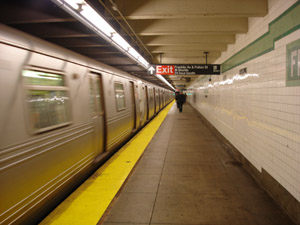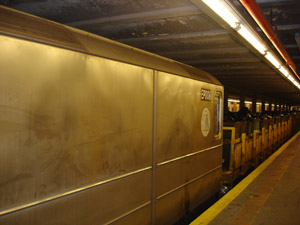Standard procedure for events like that is: get out, get on a train going back, try again. So we did, at first stop.

Walking up to look around didn't really help much, as we did not find the stairs down to the other platform. Asking people outside the subway gave us blank stares and incomprehensible mumbling. Finally we went back in and asked at the office in the subway, as we found the other subway entrance, cleverly tucked away next to a Halal fast food chicken place.
So we got on the first train back to where we thought we needed to be. My NYC connection, by now alert to the fact that we might have messed up a little, asked what train we needed to get to the R-line. The conductor answered - and at the right place we crossed over the platform. Note: crossed OVER the platform. Turned out we should have just crossed the platform. Crossing over lead us back towards where we had just been. We got off quicker this time though, to the other platform easier, and settled down to wait.

Problem was the train that made the longest stop at this station was the maintainance train. Row after row with garbage bins, no help for us. At least not for a while. OK, back to the place where we crossed over, this time simply crossing the platform. Next train in the hopefully appropriate direction.

This lead us above the ground, to views we did not recognize. And at this point my mind decided there was a lesson in this. It often works like that, when I mess around for long enough, I start thinking I am clever.
The NYC metro system is like a hypertext. Or a hypertext is like the metro system. Each link carries you from one point to another. Sometimes the only option you have is going back, sometimes you hit nodes like Union Square or Pacific Street/Atlantic Avenue, and you can go in many different directions, but no matter what, you have to get away from where you are if you want to continue exploring. This is a very absolute, digital solution: either you are here, or you are not here. Ones and Zeroes.
Stretchtext on the other hand is not absolute. As Mark Bernstein points out, it does not take you from here to there. It adds something right there. But this gives it a dreamlike quality, not the finite and absolute of Bernsteins example. Sitting on the subway somewhere lost in Brooklyn, trying to reach Bay Ridge, instead of thinking about the fact that I was shivering with the cold of my drying clothes, I tried to find a good metaphor for stretchtext, and could not find one outside of the realm of dreams.
To a certain point a stretch-text is like a building with several levels. If you want to see more of what it contains, you can go up and down the floors, without ever leaving the address. However: where a building has a finite geography that limits the number of floors and the square meters of each floor, stretchtext has no such relationship between the surface level and the further content of the text. This lack of relationship between outside and inside is more connected with magic and dreams, than with earthly geography. To enter a room which is larger on the inside is a recurring theme in descriptions of magic, while we have all walked through dreams of the houses of the past, and found that unknown doors open on rooms which never existed and could never bee there.
So, while hypertext traverses the cyberlandscape, stretchtext exists in the cyberdreamscape.
And yes, I did finally reach Bay Ridge.




No comments:
Post a Comment